|
Report from Europe
EU27 tropical wood imports slow as economic outlook
deteriorates
In the first ten months of 2022, the EU27 imported 1.68
million tonnes of tropical wood and wood furniture
products with a total value of US$3.79B, respectively 15%
and 24% more than the same period the previous year.
However, imports have been slowing since summer 2022
and the economic outlook in the EU deteriorated sharply
in the last quarter of the year. The war in Ukraine is
contributing to huge increases in energy prices, while
business and consumer confidence has been hit by
expectations of higher interest rates to control inflation.
In US dollar terms, total EU27 imports of tropical wood
and wood furniture imports were still high in October last
year compared to the same month in the previous five
years despite falling sharply since the summer (Chart 1a).

However in tonnage terms, EU27 total imports of tropical
wood and wood furniture in October last year were in line
with the level achieved in that month in the previous five
years and well below levels typical of a decade ago (Chart
1b).

EU economy projected to grow just 0.2% this year
The extent of the economic downturn in the EU27 is
highlighted in the 2023 edition of the "World Economic
Situation and Prospects" (WESP) published by the United
Nations Department of Economic and Social Affairs (UN
DESA) in January.
According to the WESP report "the economic outlook for
Europe has continued to deteriorate amid the protracted
war in Ukraine. Soaring energy prices have pushed
inflation to multi-decade highs, eroding household
purchasing power and increasing production costs for
firms. Market liquidity has tightened as the region’s
central banks have accelerated interest rate hikes to rein in
inflationary pressures. Higher borrowing costs, sizeable
fiscal deficits and elevated debt levels continue to
constrain fiscal space in many European economies”.
The WESP report also notes that “the external
environment has worsened amid weakening growth in
China and the United States and heightened global
economic uncertainty”.
Against this background, the WESP report projects that
there will a “mild recession” in many European countries
during the winter of 2022 to 2023, followed by a subdued
recovery. GDP in the European Union is projected to grow
by only 0.2 per cent in 2023, a sharp downward revision
from earlier forecasts. In 2024, the WESP forecasts that
growth will pick up to 1.6 per cent as inflation eases and
the monetary tightening cycle ends.
This comes, according to the WESP report, after a
surprisingly strong expansion of 3.3 per cent in 2022,
when further relaxation of COVID-19 mobility
restrictions and pent-up demand boosted spending on
contact-intensive services, including tourism-related
activities.
But the report observes that “in the third quarter of 2022,
consumer confidence both in the European Union and in
the United Kingdom plunged to the lowest level since the
1980s, with only a slight improvement in October and
November”.
For 2023, the WESP report states that “while the worstcase
scenario of massive disruptions to industrial activities
will likely be avoided, Europe is still projected to see a
marked economic downturn. Private consumption will
weaken due to significant purchasing power losses by
households and tightening financial conditions.
Businesses are expected to cut back on capital spending
amid elevated uncertainty and higher input and borrowing
costs. In addition, external demand is projected to soften
further as the region’s main trading partners – China and
the United States face subdued growth prospects in 2023”.
The WESP report suggests that some European countries
will be hit much harder than others. GDP is forecast to
contract in Germany, Italy, Sweden and the United
Kingdom in 2023, as these economies are particularly
vulnerable to the combination of soaring energy prices and
rising borrowing costs. By contrast, economic growth is
expected to be more resilient in a few smaller economies,
including Ireland and Portugal.
The latest data from the S&P Global eurozone
construction purchasing managers’ index (PMI) underlines
the extent of economic deterioration. It shows that the
construction sector is suffering its worst decline since the
pandemic brought the economy to a near-standstill in
2020.
December’s PMI showed a total activity index of 42.6,
down from 43.6 in November. Figures below 50 indicate
declining activity. The data marked the eighth consecutive
month of contraction in home building. Activity declined
in all three of the 20-nation bloc’s biggest economies —
Germany, France and Italy.
Excluding periods of Covid-19 lockdowns, total homebuilding
activity dropped in December at the sharpest rate
since March 2013 and new orders for all construction
projects declined at the fastest rate since September 2014,
S&P said. The biggest falls in both cases were in
Germany. Commercial building activity also fell for the
ninth consecutive month, said S&P, adding that the
biggest drop was in France.
The gloomy findings underline how rising borrowing
costs, sharply higher raw material prices and worries that a
recession could accelerate a fall in property prices are all
weighing on the European construction industry.
According to the S&P “December data suggested that
firms were anticipating challenging economic conditions
to continue into the future”. More positively, S&P
reported a “sustained easing” in both cost and supply
pressures.
Rise in EU27 import value of tropical furniture masks
fall in quantity
In the first ten months of 2022, EU27 import value of
wood furniture from tropical countries was US$1.52B,
14% higher than the same period in 2021. This increase in
dollar value was entirely due to higher freight rates and
prices and the weakness of the euro last year. In tonnage
terms, imports declined 6% to 305,500 tonnes during the
ten-month period.
In the first ten months of 2022, there were large increases
in EU27 wood furniture import value from Vietnam
(+21% to US$626M), Indonesia (+23% to US$454M),
Malaysia (+17% to US$108M) and the Philippines (+17%
to US$8M). Import value fell from India (-7% to
US$284M) and Thailand (-3% to US$25M). EU27 wood
furniture imports from all other tropical countries were
negligible (Chart 2).

EU27 imports of tropical sawnwood up 24%
After two slow years during the global pandemic, EU27
imports of tropical sawnwood recovered ground in the first
ten months of last year. Imports of 869,000 cubic metres
between January and October last year were 24% higher
than the same period in 2021 and 34% more than the same
period in 2020.
Sawnwood imports increased during the ten-month period
last year from all the largest tropical suppliers to the EU27
including Cameroon (+23% to 306,400 cubic metres),
Brazil (+47% to 148,700 cubic metres), Gabon (+18% to
133,600 cubic metres), Malaysia (+29% to 77,000 cubic
metres), Congo (+20% to 65,600 cubic metres) and Ghana
(+17% to 25,800 cubic metres).
Of smaller sawnwood supply countries, there were large
percentage increases in imports from DRC (+113% to
11,500 cubic metres), Suriname (+64% to 9,400 cubic
metres), Indonesia (+46% to 9,000 cubic metres), Angola
(+35% to 6,200 cubic metres), and CAR (+167% to 5,700
cubic metres). In contrast imports from Côte d'Ivoire fell
26% to 16,800 cubic metres and from Ecuador were down
17% to 25,800 cubic metres. (Chart 3).

Unlike sawnwood, EU27 imports of tropical
mouldings/decking were slow between January and
October last year. Imports of 156,600 tonnes between
January and October 2022 were just 1% more than the
same period in 2021.
Supply shortages contributed to falling imports from
Indonesia, which declined 12% to 48,000 tonnes during
the ten-month period. The fall in imports from Indonesia
was offset by rising imports from Brazil (+2% to 60,800
tonnes) and Gabon (+72% to 12,400 tonnes).
Of smaller suppliers, there were increases in imports from
Bolivia (+36% to 7,000 tonnes) and Malaysia (+25% to
6,400 tonnes). Imports from Peru declined by 2% to
11,900 tonnes in the first ten months of last year after
strongly rising the previous year (Chart 4).
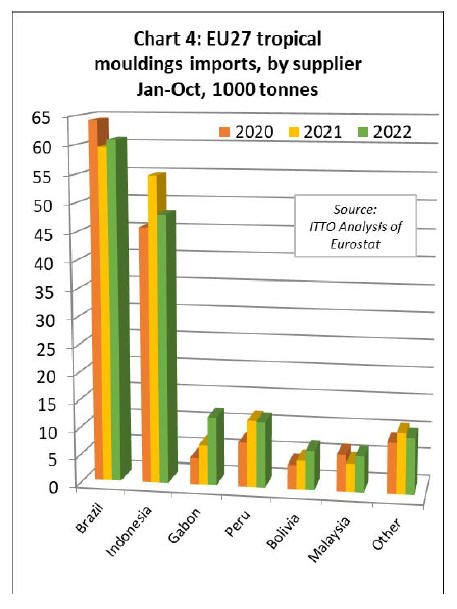
Between January and October 2022, the EU27 imported
98,100 cubic metres of tropical logs, 14% more than the
same period in 2021. (Chart 5)
EU27 log imports increased from all three of the largest
African supply countries in the first ten months of last year
compared to the same period in 2021; Congo (+7% to
40,400 cubic metres), CAR (+31% to 20,100 cubic
metres), and DRC (+56% to 11,200 cubic metres).
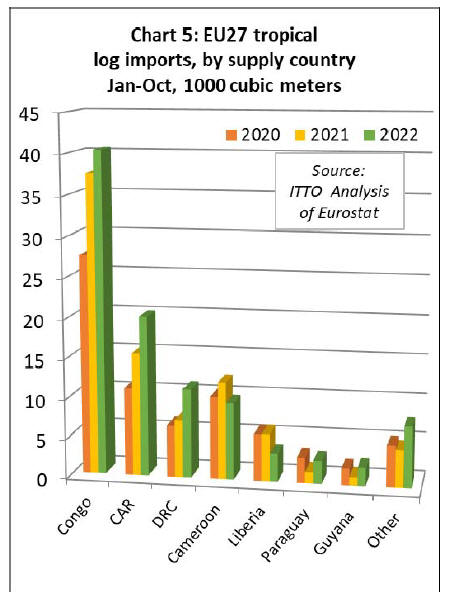
In the first ten months of last year imports also increased
sharply from negligible levels in 2021 from two South
American countries, Paraguay (+101% to 2,900 cubic
metres) and Guyana (+123% to 2,300 cubic metres).
However, log imports were down 21% to 9,700 cubic
metres from Cameroon and down 40% to 3,600 cubic
metres from Liberia.
Large gains in EU27 imports of tropical hardwood
veneer from Africa
Between January and October 2022, the EU27 imported
298,300 cubic metres of tropical veneer, 22% more than
the same period in the previous year.
Imports of tropical veneer from Gabon, by far the largest
supplier to the EU27, increased 16% to 148,800 cubic
metres. There were also large gains in imports from Côte
d'Ivoire (+34% to 71,300 cubic metres), Cameroon (+45%
to 35,100 cubic metres) and Equatorial Guinea (+53% to
6,800 cubic metres).
After virtually no indirect trade in tropical veneer to the
EU27 via the UK in 2021, this trade totalled 4,600 cubic
metres between January and October last year. These gains
in EU27 tropical veneer imports were partly offset by a
12% decline in imports from Congo to 13,400 cubic
metres and a 3% fall in imports from Ghana to 7,500 cubic
metres (Chart 6).
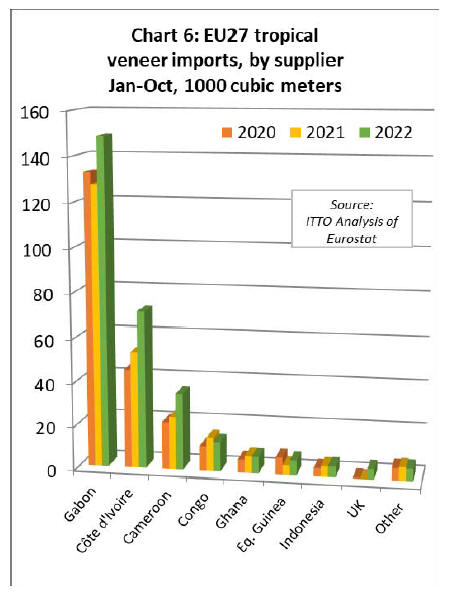
Between January and October 2022, EU27 tropical
plywood imports of 257,900 cubic metres were 39% more
than the same period the previous year. Imports from
Indonesia, at 79,100 cubic metres, were up 17% compared
to the same period in 2021.
However, the biggest percentage increases were in imports
from Gabon and Vietnam, both rising 130% to 61,300
cubic metres and 23,000 cubic metres respectively.
Imports of tropical plywood also increased from Morocco
(+63% to 18,700 cubic metres), Brazil (+119% to 13,400
cubic metres), India (+33% to 9,700 cubic metres), and the
UK (+10% to 7,300 cubic metres).
Tropical plywood imports from Paraguay increased from
negligible levels in 2021 to 3,500 cubic metres in the first
ten months of last year. These gains offset a 28% decline
in imports of tropical hardwood faced plywood from
China to 27,000 cubic metres (Chart 7).
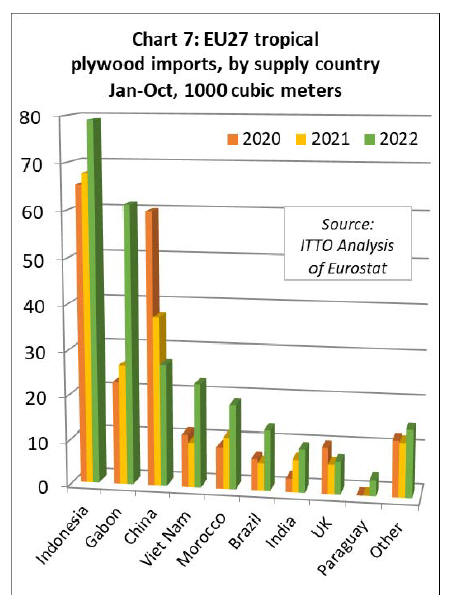
Rise in EU27 imports of tropical flooring from Malaysia
continues
Between January and October 2022, the EU27 imported
24,500 tonnes of tropical wood flooring, 38% more than
the same period in 2021. The rise in EU27 wood flooring
imports from Malaysia that began in 2020 continued last
year.
Imports of 11,600 tonnes from Malaysia in the first ten
months of 2022 were 49% more than the same period in
2021.
There were also large gains, from a smaller base, from
Indonesia (+39% to 6,000 tonnes) and Brazil (+46% to
2,300 tonnes). Flooring imports from Vietnam were, at
2800 tonnes in the ten month period, at the same level as
the previous year (Chart 8).
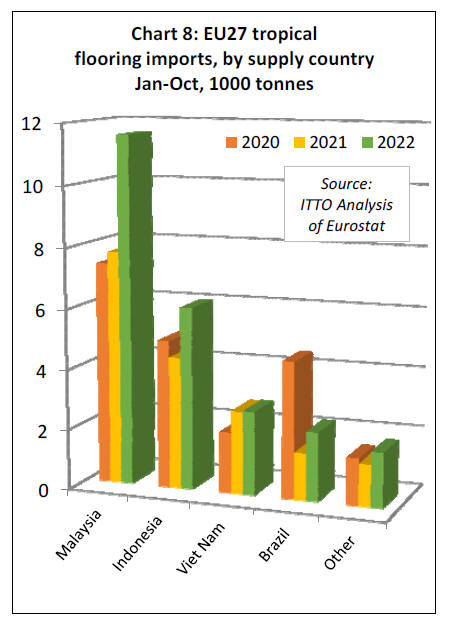
The dollar value of EU27 imports of other joinery
products from tropical countries - which mainly comprise
laminated window scantlings, kitchen tops and wood
doors - increased 40% to US$249M in the first ten months
of 2022. Import value increased 12% to US$108M million
from Indonesia, 69% to US$77M from Malaysia, and 27%
to US$24M from Vietnam. (Chart 9)
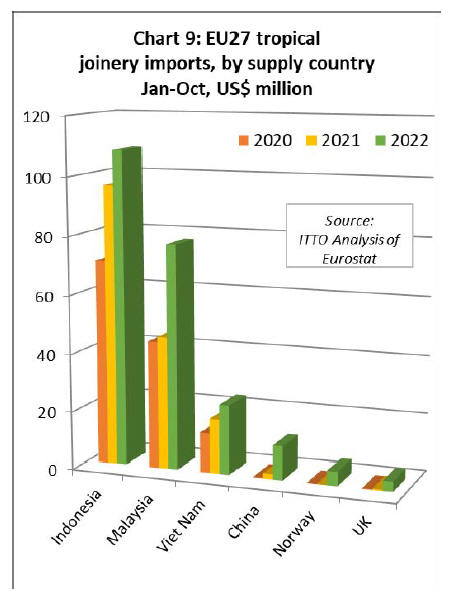
The apparent large increase in imports of this commodity
group from China, from negligible levels to US$12M in
the first ten months of last year, is due to a change in
product codes from the start of 2022 allowing more
joinery products manufactured using tropical hardwood in
non-tropical countries to be separately identified (Chart 9).
Unlike for furniture, the rise in import value for joinery
last year was not driven entirely by rising prices but was
also indicative of an increase in import quantity. In
quantity terms between January and October last year, the
EU27 imported 92,800 tonnes of tropical joinery products,
29% more than the same period in 2021.
|